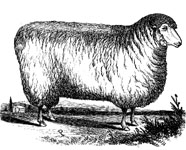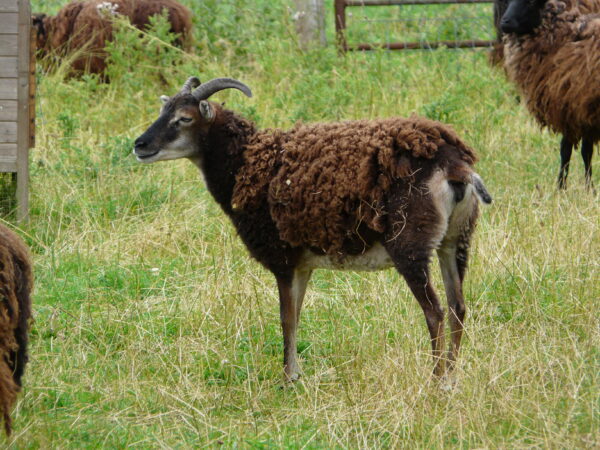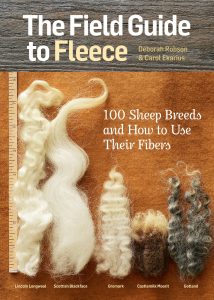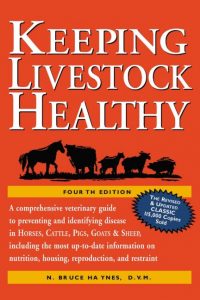
Breed Facts
Status:
Threatened
Use:
Meat, Wool/Fiber
Adult Weight:
Rams/Ewes: 50 – 80 lbs.
Temperament:
Alert, Shy, Curious
Experience Level:
Novice – Intermediate
Notes:
Hardy, parasite/disease resistant; independent; ewes polled or horned; rams typically horned; not a good choice to use with herding dogs
SOAY – BRITISH SHEEP
The British Soay is an ancient, short-tailed breed of sheep that descend from a feral population on the 250-acre island of Soay (Seyðoy – Norse for “Sheep Island” – indicating a connection to the Vikings), in the St. Kilda archipelago of Scotland’s Outer Hebrides, about 40 miles from the Western Isles of Scotland. The uninhabited island has high winds and variable weather, and only the toughest sheep survived. Until 1930, crofters from the nearby island of Hirta visited the island to gather the wool from these feral sheep that was shed on the rocks. This wool was softer than the wool from their own sheep and was blended by weavers for products that were bartered to pay rent or sold.
While the primary population remains on the islands, some of the sheep were brought onto the UK mainland, and there were later exports to Europe and North America. The first North American imports of the British Soay began in 1990, first to Montreal and then south to the US. The population on the islands fluctuates between about 800 to 2000 sheep, and is now closed to emigration or immigration.
About 450 Soay sheep were registered in the UK in 2021, and about 90 British Soay were registered from North America. Registration occurs through the Rare Breeds Survival Trust (RBST) Combined Flock Book.
Soay sheep are small (50-80 lbs.), nimble and almost deerlike sheep, with slender bones and clean faces and legs. Ewes are polled, scurred, or horned, and rams are scurred or horned. They are generally brown or tan, and have a white belly, rump, and/or white area under their chin (called the mouflon or wild pattern). They occasionally have white markings on the face/body/legs. Self-colored black or tan (solid with no markings) animals are sometimes seen.
Soay wool is cast (shed) in the springtime and can be rooed (hand plucked). Fiber quality varies from wooly to kempy with colors ranging from light brown to near black. Their fleece can be extremely fine and the undercoat may be indistinguishable from the outer coat. Some fleeces have been compared to “quiviut” from musk oxen.
Ewes can lamb easily for up to 10 years and they are good mothers. However, the tiny size of lambs makes them vulnerable to predators, including large raptors, so it is wise to provide protection for lambs and ewes, especially if the ram is kept separately.
Soay also produce a mild-tasting (though a bit more gamey), low-fat meat, low cholesterol meat.
Their small stature belies the breed’s hardiness, resilience and self-sufficiency. Their isolation in the harsh North Atlantic environment has created a cold-hardy, parasite-and-disease resistant, resilient sheep. The breed does not have the flocking instinct of some other sheep breeds – attempts to herd with dogs will only scatter and stress the sheep. Soay sheep, like antelope, “stott” (sprint-jump) when they are startled.
The breed can thrive on marginal pasture that would be inadequate for other sheep breeds, but they can become overweight quickly on lush grass or grain.
With their small size and lighter impact on the soil, they are useful for ecologically-sound grazing programs, and could be especially useful in solar farm or vineyard grazing situations. However, they should not have access to rhododendrons or azaleas which are toxic to the breed.
Although Soay sheep are shy and curious, and with regular, gentle exposure to humans, ewes and whethers can make good pets, they are a breed best suited to more experienced shepherds.
Be aware that there are two types of Soay sheep are present in North America: the British Soay and the American Soay. The American Soay is a larger sheep that is not listed on the CPL. British Soay sheep born in North America can be registered in the RBST Combined Flock Book if their parents were registered in that Flock Book.
Did you know:
The Conservation Priority List is organized historically. Breeds originating in North America are listed first, followed by those imported before 1900 and those that came
to our shores later. Many of these breeds were founded in the United States. That means we have a special responsibility for their conservation. You can invest in living history for as little as $4 per month. Click here to become a Conservation Champion today!
You may be interested in…

Breed Facts
Status:
Threatened
Use:
Meat, Fiber
Adult Weight:
50 – 80 lbs
Temperament:
Docile, Alert
Experience Level:
Novice – Intermediate
Notes:
Hardy, resilient, independent; ewes polled or horned; rams typically horned
You may be interested in…




